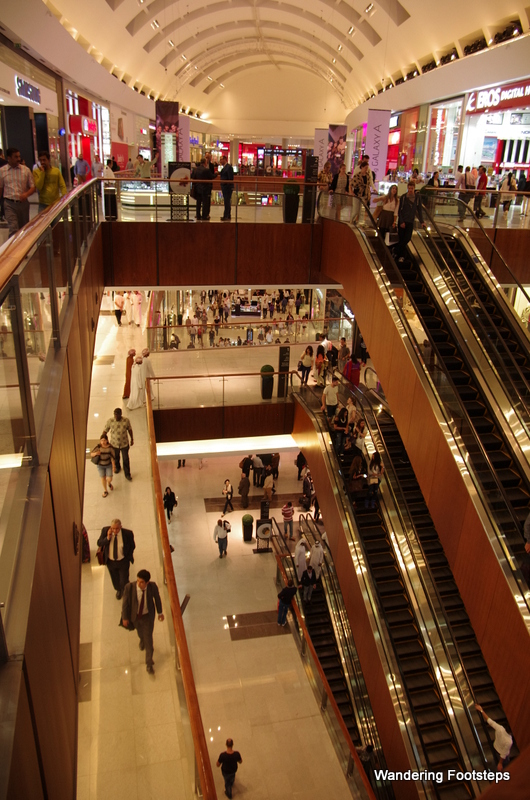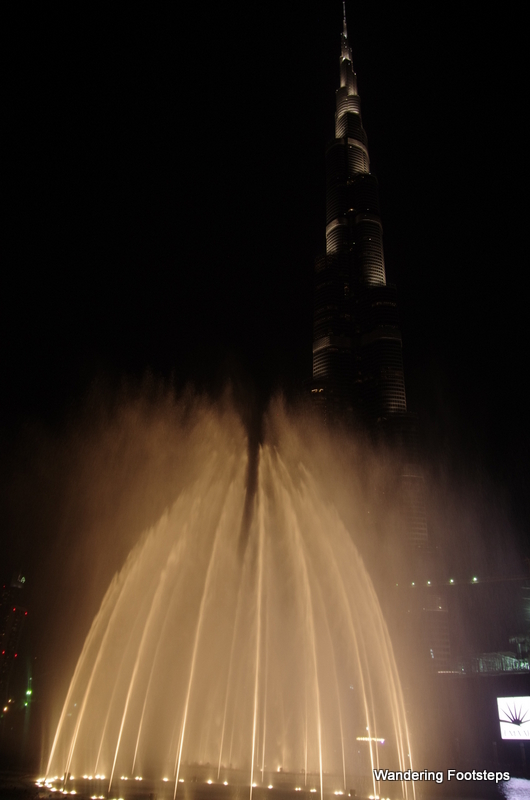We are at the Dubai Mall, the world’s largest. We’ve been to the cinema, climbing four floors to reach Theater #20. We’ve eaten in the giant food court, marvelling over the myriad American fast-food chains before us. We’ve seen the sharks and rays in the mall’s giant indoor aquarium. And now, we’re standing outside, at the foot of the Dubai Fountain, waiting for the water and light show to start. Burj Khalifa, the tallest tower in the world, faces us, its sleek height accentuated by its night lights.
The crowd packs in around us, a multicultural group of tourists, Emiratis, and South Asian expats. The music begins in a low rumble, and water jets up into the sky. For three minutes, the fountain forms different shapes, patterns, sounds, and colors, all in time with music. The entire scene is, admittedly, breathtaking. But I find myself wondering, for a moment, where on earth Bruno and I have landed. My brain feels like the water crashing up from the Dubai Fountain as I struggle to make sense of this glitziest of cities.

The Dubai Mall – the largest mall in the world.
.jpg)
The indoor aquarium at the Dubai Mall.

The water and lights show at the Dubai Fountain, with Burj Khalifa (the tallest tower in the world) behind.
The United Arab Emirates, as it is known today, is a relatively new country. When, in the 1960s, oil was discovered in Abu Dhabi, the then sheikh (leader), Zayed bin Sultan al Nahyan, successfully convinced the surrounding sheikhdoms to organize themselves in a union that would control economic and business decisions surrounding their new oil wealth. Though Bahrain and Qatar opted not to join the union, the other seven sheikhdoms created what is now known as the United Arab Emirates. The country has just celebrated the 43rd year of their union.

Celebrating the 43rd year of the union of seven emirates.
Those first few days, as we drove through the western half of the country, we passed more oil fields – and accidentally drove down restricted, oil-access-only, roads – than I’ve ever seen in my life. It had seemed that the UAE was sticking close to its oil roots. By the time we reached Dubai, however, it was obvious that at least one of the emirates had shed its oil image in favour of more lucrative – and glamorous – foreign investment.
Dubai is the ultimate City of Superlatives. They have the world’s tallest tower (almost a kilometer high!), the largest mall (with an ice skating rink and an underwater zoo!), and the only seven star hotel in the world. They have two artificial palm-tree-shaped islands and another one in the shape of the world. And they have the world’s largest concentration of luxury cars. I know this for a fact, because Bruno’s incessant pointing out of Maseratis, Rolls’ Royces, and Bentleys’ has become, frankly, annoying.

Just a few of the nice cars in Dubai… they look really rather ordinary, once you’ve been here a few days.

Burj al Arab, the only seven star hotel in the world.
It’s not just Dubai, though – the entire country has Superlative Fever. In Al Ain, Bruno and I drove up “one of the world’s best, award-winning, mountain roads” to reach the summit of Jebel Hafeet mountain. Outside of Abu Dhabi, Bruno and I visited Sheikh Hamad Bin Hamdan Al Nahyan’s Guinness Book World Record-holding car collection, which includes the largest caravan and the biggest 4×4 in the world. In both instances, I was disappointed. The experiences, rather than being superlative, were rather ordinary.

At the summit of the Jebel Hafeet mountain.

“One of the best mountain roads in the world,” leads to Jebel Hafeet mountain.
I expected to have a similar experience at the Sheihk Zayed Grand Mosque, yet another UAE Superlative. I’d read the stats. I knew that it was constructed of marble, with pure gold bordering, taking over 3,000 workers and 38 contracting companies almost a decade to build. I knew that inside the main hall lay the world’s largest carpet, almost 6,000 meters long with over 2 billion knots, and having taken almost two years to complete. I even knew that the courtyard, decorated with marble flowers, was the largest example of marble mosaic in the world. I fully expected the grandiose mosque to feel ostentatious.
We wandered around the mosque grounds for several hours, taking in the semi-precious stones and Swarovski crystal chandeliers. The mosque was packed with people snapping selfies on their iPhones. As I expected, it didn’t feel at all like the spiritual place it was built to be. The only cultural part of the experience was me getting to wear an abaya for the first time, as per the mosque dress-code.

The Sheikh Zayed Grand Mosque, in Abu Dhabi.

Posing with our abayas, the floral marble mosaic behind.

The infamous Iranian rug.
Until the call to prayer, that is. As the last light of day faded from the sky and the mosque was lit up in pale spotlight, the muezzin began his call to prayer. He chanted a cappella, in perfect pitch, meandering through notes as he called out to the faithful. It gave me goose bumps. I snuck into the women’s side prayer room and watched women and children prostrate themselves on the hand-stitched Iranian carpet. Outside, the tourists grew silent and put down their iPhones.
Now the mosque felt like more than just a flashy display of wealth.

The jewels inside lit up at night.

Locals coming to pray.

Sunset, and the call to prayer, brought on a new beauty to the mosque.
My experience at the Grand Mosque wasn’t the only time I’ve been surprised by simple moments of culture and history in the UAE. During our time in Al Ain, we visited the Palace Museum, and saw first-hand what the sheikhs’ lives were like prior to the discovery of oil. Though not impoverished by any means, the palace was simple, the furniture was humble, and the custom of drinking coffee and munching on dates was displayed as the favored time-pass for the royal family.
Behind the disused palace was an even greater surprise. An old date palm oasis spread out for miles and miles. Parcels of the land were carved out and surrounded by cement wall, workers were tilling the land, and owners popped by to check on their crops. The date palm oasis that had existed here for centuries was still active – and was still producing dates! We wandered around the oasis for an hour or so, enjoying the cool shade, the bird chirps, and the surprising peace in the center of one of the UAE’s largest cities!

One of the largest rooms in the old palace.

Pretending to pour tea and serve dates, as was the custom in the sheikh’s pre-oil palace.

Marveling at the peace of the date palm oasis in the center of Al Ain.
The highway between Al Ain and Dubai cuts through red sand desert. As I stared out the window and the endless sea of sand, I spotted a herd of camels climbing a dune. At the tail of the herd was a man – their herder – dressed in the traditional loose white dress and red-checkered turban of a Gulf Arab. He was driving a shiny new four-wheeler.
“It must be the new way the locals herd their camels,” joked Bruno.
I thought of the mosques mixing in with the modern skyline of Dubai; of the traditionally dressed families on Friday afternoon outings in Rolls’ Royces; of camel races held in the desert outskirts of the cities; and of women in black abayas buying the latest gadgets at the Dubai mall.

Mosques and modern skyscrapers – this is the skyline of Dubai.

Camel races in the desert.

Traditionally-clothed Gulf Arabs shopping for Nike wear!
That man herding his camels to a nearby desert oasis aboard a four-wheeler was no surprise to me. He was the epitome of the United Arab Emirates as I’ve experienced it so far; a country that may seem, on the surface, to have superlatively bounded into the modern age with two wholehearted feet, but that still holds on to a few surprising traditions for those willing to look.

The new way to herd camels in the UAE.



Lisa Mahoney - A mutual friend, Noreen Lavallee, gave me your blog site. We just got back from Dubai and our son lives there now so she thought I’d find your blog interesting. Very! I had the same feeling at the Grand Mosque and also got chills when the call to prayer came over the speakers. You have done an excellent job of capturing the Dubai I feel like I experienced. Enjoy your travels and I look forward to reading more.
Brittany - Thank you very much for reading and for sending your comments, Lisa! (And a shout-out to the Lavallee family!) What is your son doing for work in Dubai? My husband and are currently on the Musandam Peninsula of Oman, but are heading back to Dubai today for our last ten days on the Arabian Peninsula. I’m looking forward to it – somehow, Dubai became a home away from home! I hope your son enjoys his time there and that you are able to return again (especially during the Canadian winter!). Thanks again for stopping by to say hello! 🙂
Brittany Caumette - Glad to hear you enjoyed the story, dad! I didn’t expect to find a whole lot of tradition, history, or culture, so have been pleasantly surprised so far!
rcs - A truly wonderful read; you capture the contradiction of old and new in juxtaposition. I was disappointed the article ended…